If you’re a Florida gardener dreaming of growing your own tropical fruit paradise, look no further than the magnificent banana plant. With their lush foliage and delicious fruit, bananas can thrive in Florida’s subtropical climate. Let’s explore the best varieties suited for each zone, share valuable tips on growing conditions, soil requirements, and planting times, and find out more about how to grow bananas in Florida.
Ornamental vs. Edible Bananas
Before we delve into the specifics, it’s important to distinguish between ornamental and edible bananas. While both types offer stunning foliage, ornamental varieties produce inedible or barely edible fruit. To truly enjoy the flavor and sweetness of homegrown bananas, opt for edible varieties specifically bred for fruit production.
It’s important to note that while these ornamental varieties add visual interest to gardens, their fruit is either inedible or of very poor quality. Therefore, for those looking to grow bananas for their delicious fruit, it’s essential to select edible banana varieties specifically bred for fruit production.
Here are some varieties to avoid if you’re hoping for a harvest:
- Musa ornata: Known for its vibrant pink inflorescence and attractive dark green leaves with red midribs, this ornamental banana adds a touch of tropical beauty to gardens.
- Musa velutina: Also called the Pink Banana, this variety showcases stunning pink fruits and velvety pink bracts. It’s a favorite among collectors for its ornamental appeal.
- Ensete ventricosum ‘Maurelii’: While technically a close relative of the banana, this ornamental variety, commonly known as the Red Abyssinian Banana, is primarily grown for its striking red foliage.
- Musa sikkimensis ‘Red Tiger’: This ornamental banana boasts maroon-red leaves with prominent green stripes, creating a visually captivating display in gardens and landscapes.
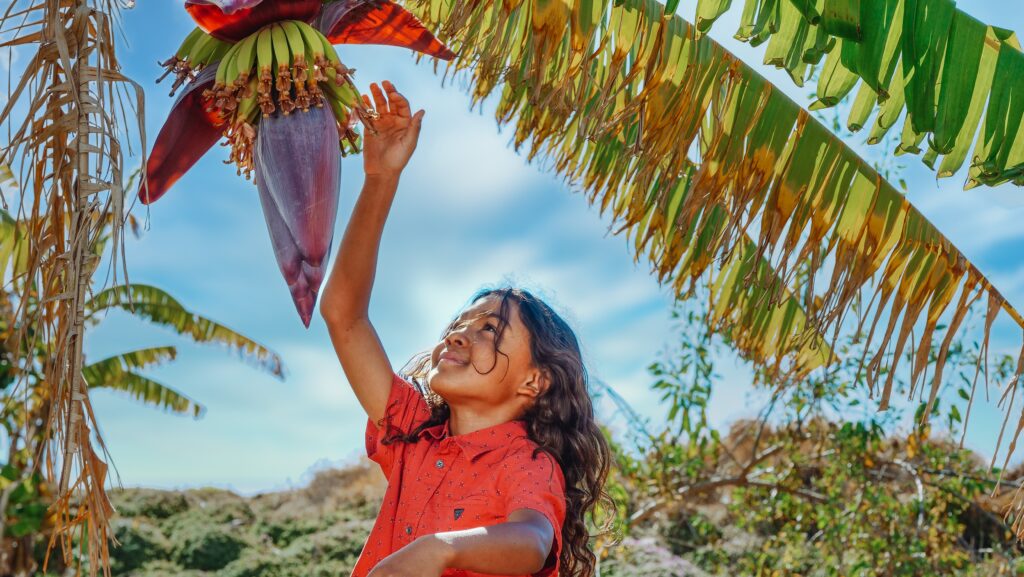
Best Banana Varieties to Grow in Florida
Growing bananas successfully in Florida requires selecting suitable varieties for each USDA zone. Let’s explore some of the top banana types known to thrive in the Sunshine State:
North Florida / Zone 8:
- ‘Dwarf Cavendish’ (Musa acuminata): This compact variety grows well in containers, making it ideal for Zone 8 gardens. It produces tasty, medium-sized bananas with a pleasant flavor profile.
Central Florida / Zone 9:
- Goldfinger Banana (FHIA-01): Resistant to Panama disease, this variety excels in Zone 9. Its creamy fruit has a sweet flavor reminiscent of dessert bananas.
- Lady Finger Banana (Musa acuminata ‘Lady Finger‘): Thriving in Zone 9, these slender, aromatic bananas offer a delicate and sweet taste.
South Florida / Zone 10:
- Mona Lisa Banana (FHIA-2): Perfect for Zone 10, this variety produces large bunches of sweet, aromatic bananas. It offers excellent disease resistance and handles Florida’s hot climate well.
- Honey Banana (Musa johnsii): Well-suited for Zone 10, this unique banana variety features a honey-like flavor and attractive red-purple skin when ripe.
Choosing Banana Plants for Your Florida Garden
I don’t know about you, but when they’re small, all bananas pretty much look the same to me. It’s always a good idea to choose the variety carefully, so look for the label when you’re at your local nursery. If you don’t see one, ask someone. You really don’t want to end up with an ornamental type when you’re hoping to be making home-grown banana bread someday.
Dwarf Cavendish
‘Dwarf Cavendish’ (Musa acuminata) is a popular banana variety renowned for its compact size and delectable fruit. This cultivar typically reaches a height of around 6 to 8 feet (1.8 to 2.4 meters) at maturity, making it an excellent choice for smaller gardens or container cultivation.
The ‘Dwarf Cavendish’ features broad, lush green leaves that create a tropical ambiance wherever it grows. This variety takes approximately 2 to 3 years to reach maturity and begin flowering, producing pendulous clusters of creamy yellow fruit.
The fruit of the ‘Dwarf Cavendish’ is medium-sized, with a smooth, thin skin that turns yellow when ripe. Its flavor is delightfully sweet, often described as having a subtle and creamy banana taste with hints of tropical notes.
When fully ripened, the ‘Dwarf Cavendish’ offers a luscious and satisfying eating experience, making it a favorite choice for banana enthusiasts.
Goldfinger
The Goldfinger Banana (FHIA-01) is a remarkable banana variety known for its resistance to several diseases, making it an excellent choice for growers. This hybrid cultivar combines the genetics of the wild banana (Musa balbisiana) and the Dwarf Cavendish (Musa acuminata).
At maturity, the Goldfinger Banana typically reaches a height of 8 to 10 feet (2.4 to 3 meters) with a spread of about 4 to 6 feet (1.2 to 1.8 meters). It exhibits sturdy and upright growth habits, producing large, attractive leaves with green foliage. The Goldfinger Banana matures in approximately 9 to 12 months and starts flowering when it reaches about 7 feet (2.1 meters) in height.
The fruit it bears is elongated and has a vibrant yellow skin when fully ripe. The flavor profile of the Goldfinger Banana is exquisite, with a rich and sweet taste complemented by hints of tropical flavors.
Its firm and creamy texture enhances the overall culinary experience, making it a highly desirable choice for both fresh consumption and culinary uses.
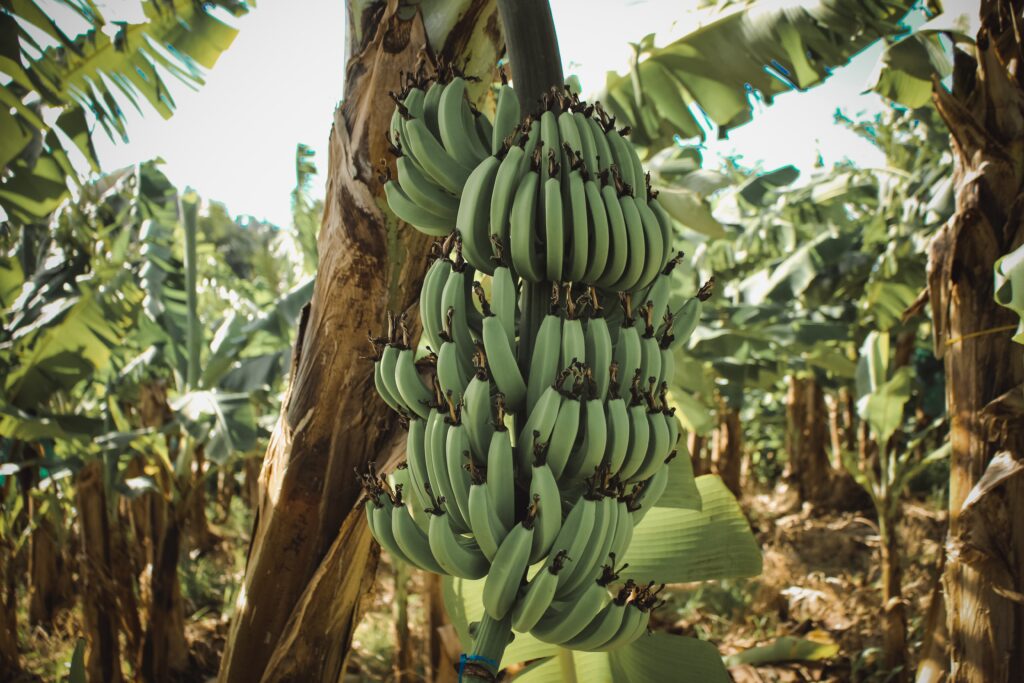
Lady Finger
The Lady Finger Banana (Musa acuminata ‘Lady Finger‘) is a distinguished banana variety appreciated for its petite size and delectable fruit. Also known as “Sucrier” or “Sugar Banana,” this cultivar is treasured for its sweetness and fine texture.
The Lady Finger Banana typically grows to a height of 6 to 8 feet (1.8 to 2.4 meters) at maturity, with a spread of approximately 3 to 5 feet (0.9 to 1.5 meters). It displays an upright growth habit, producing slender leaves that add an elegant touch to any garden. This variety takes around 12 to 16 months to reach maturity and begin flowering.
The fruit of the Lady Finger Banana is small and cylindrical, with a thin golden-yellow skin when fully ripe. Its flesh is creamy and tender, offering a delectable balance of sweetness and subtle tanginess.
The Lady Finger Banana is often praised for its dessert-like flavor, reminiscent of vanilla and honey. Its petite size and exceptional taste make it a favorite choice for enjoying fresh or incorporating into various culinary creations.
Mona Lisa
The Mona Lisa Banana (FHIA-2) is a captivating banana variety that stands out for its exceptional flavor and ornamental features. This hybrid cultivar, bred from the Honduran Foundation for Agricultural Research (FHIA), offers both aesthetic appeal and delectable fruit.
The Mona Lisa Banana grows to a height of about 10 to 12 feet (3 to 3.6 meters) at maturity, with a spread of approximately 5 to 6 feet (1.5 to 1.8 meters). It showcases large, lush green leaves that create a tropical ambiance in any garden. This variety typically takes around 12 to 14 months to reach maturity and start flowering.
The fruit of the Mona Lisa Banana is medium-sized, with a slightly curved shape and a vibrant yellow color when ripe. Its flavor profile is highly regarded, characterized by a rich, sweet taste with hints of caramel and hints of citrus. The fruit’s creamy texture further enhances the eating experience.
The Mona Lisa Banana excels as a dessert banana due to its delectable flavor and also adds an aesthetic appeal to landscapes and gardens with its lush foliage and graceful presence.
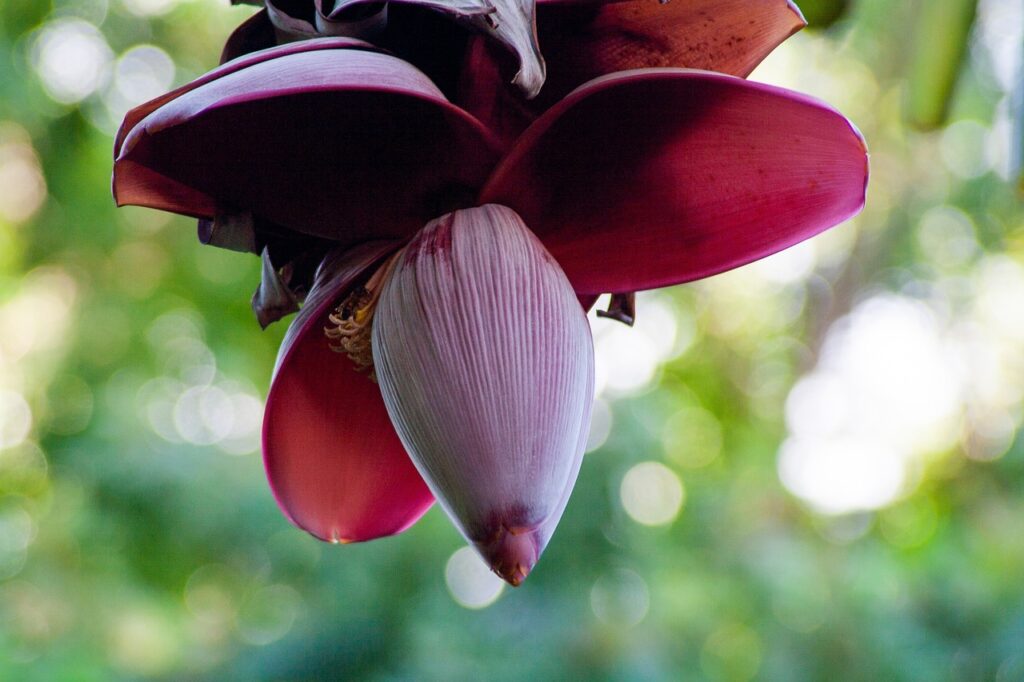
Honey Bananas
Honey Banana (Musa johnsii) is a unique and lesser-known banana variety that offers a delightful taste and distinctive characteristics. This species is highly regarded for its exceptional sweetness, earning its name “Honey Banana.”
The Honey Banana plant reaches a height of about 6 to 8 feet (1.8 to 2.4 meters) at maturity, with a spread of around 3 to 4 feet (0.9 to 1.2 meters). It displays a compact growth habit, making it suitable for smaller gardens or container cultivation. The time it takes for Honey Bananas to reach maturity and start flowering is approximately 12 to 14 months.
The fruit of the Honey Banana is medium-sized with a slender shape and a bright yellow skin when fully ripe. Its flavor is the highlight, characterized by an intense sweetness reminiscent of honey, along with subtle floral notes. The Honey Banana’s velvety smooth texture adds to the overall eating experience.
While not as widely known as some other banana varieties, the Honey Banana surprises with its unique flavor profile, making it a delightful choice for those seeking a distinct and sweet tropical treat.
Blue Java
The Blue Java banana (Musa acuminata × balbisiana ‘Blue Java’) is a fascinating and sought-after banana variety, renowned for its unusual blue-green coloration and distinctive flavor. This cultivar, often referred to as the “Ice Cream Banana,” offers a unique combination of visual appeal and delectable taste.

The Blue Java banana plant reaches a height of 10 to 20 feet (3 to 6 meters) at maturity, with a spread of approximately 6 to 8 feet (1.8 to 2.4 meters). It displays a robust growth habit, with large, sturdy leaves that create a lush tropical atmosphere. The time it takes for the Blue Java banana to grow to maturity and start flowering is typically around 12 to 20 months.
The fruit of the Blue Java banana is medium-sized, with a thick, pale blue-green skin when fully ripe. Its flavor is what sets it apart, often described as resembling vanilla ice cream or custard. The flesh is creamy and velvety, offering a rich and sweet taste with subtle hints of vanilla.
The Blue Java banana’s unique flavor profile, combined with its visually stunning appearance, makes it a highly sought-after variety among banana enthusiasts and a true delight for those seeking a tropical treat with a twist.
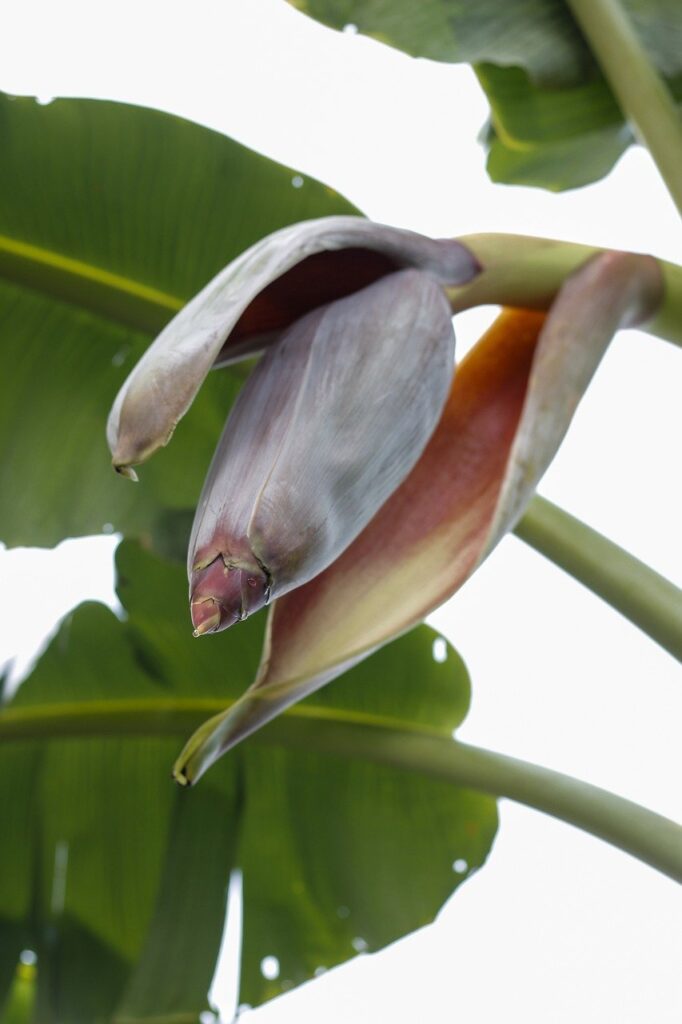
Plantains vs. Bananas
Plantains, often confused with bananas, are a versatile staple in tropical cuisine. While they resemble bananas, plantains require different cooking methods due to their starchier texture. Plantains are often cooked before consumption and used in various savory dishes.
Best Plantain Bananas to Grow in Florida
To enjoy the goodness of plantains in your Florida garden, consider these top varieties:
Platano Burro
Well-adapted to Florida’s climate, this plantain variety offers large, starchy fruit with a mildly sweet flavor.
Platano Burro (Musa paradisiaca), also known as the “Burro Banana” or “Horse Banana,” is a popular plantain variety valued for its versatility and distinct flavor. Unlike sweet bananas, the Platano Burro is primarily used for cooking due to its starchy nature.
This plantain cultivar grows to a height of 15 to 20 feet (4.5 to 6 meters) at maturity, with a spread of approximately 10 to 15 feet (3 to 4.5 meters). It displays large, broad leaves that provide a tropical ambiance to the landscape. The time it takes for the Platano Burro to reach maturity and start flowering is typically around 12 to 16 months.
The fruit of the Platano Burro is larger and more angular compared to sweet bananas, with a thick green skin that turns yellow-black as it ripens. When cooked, the fruit takes on a soft and creamy texture, perfect for making delicious dishes such as plantain chips, mashed plantains, or plantain fritters.
The flavor profile of the Platano Burro is unique, offering a mild, slightly sweet taste with subtle hints of tanginess. Its versatility in various culinary applications, combined with its hearty and flavorful nature, makes the Platano Burro a favored choice among those seeking to explore the world of plantain-based cuisine.
Saba
Thriving in Florida’s warm climate, Saba plantains produce large, starchy fruit perfect for cooking and frying.
The Saba Plantain (Musa acuminata × balbisiana ‘Saba’) is a popular and robust plantain variety cherished for its versatility in both cooking and baking. This hybrid cultivar, known for its large size and starchy texture, is highly valued in tropical cuisines.
The Saba Plantain grows into a sizeable plant, reaching heights of 15 to 20 feet (4.5 to 6 meters) at maturity, with a spread of approximately 10 to 15 feet (3 to 4.5 meters). It showcases broad leaves that create a lush and tropical atmosphere in the garden. The time it takes for the Saba Plantain to mature and start flowering typically ranges from 10 to 14 months.
The fruit of the Saba Plantain is elongated and thick-skinned, transitioning from green to yellow-black as it ripens. Unlike dessert bananas, the Saba Plantain is not typically consumed raw due to its starchy nature. When cooked, however, it transforms into a delectable treat. The flavor profile of the Saba Plantain is characterized by a mildly sweet taste and a dense, creamy texture.
Its versatility makes it ideal for a wide range of culinary creations, from savory plantain chips and stews to delectable plantain bread or cakes. The Saba Plantain’s substantial size, adaptability, and hearty flavor make it a staple ingredient in many tropical cuisines and a favorite among plantain enthusiasts.
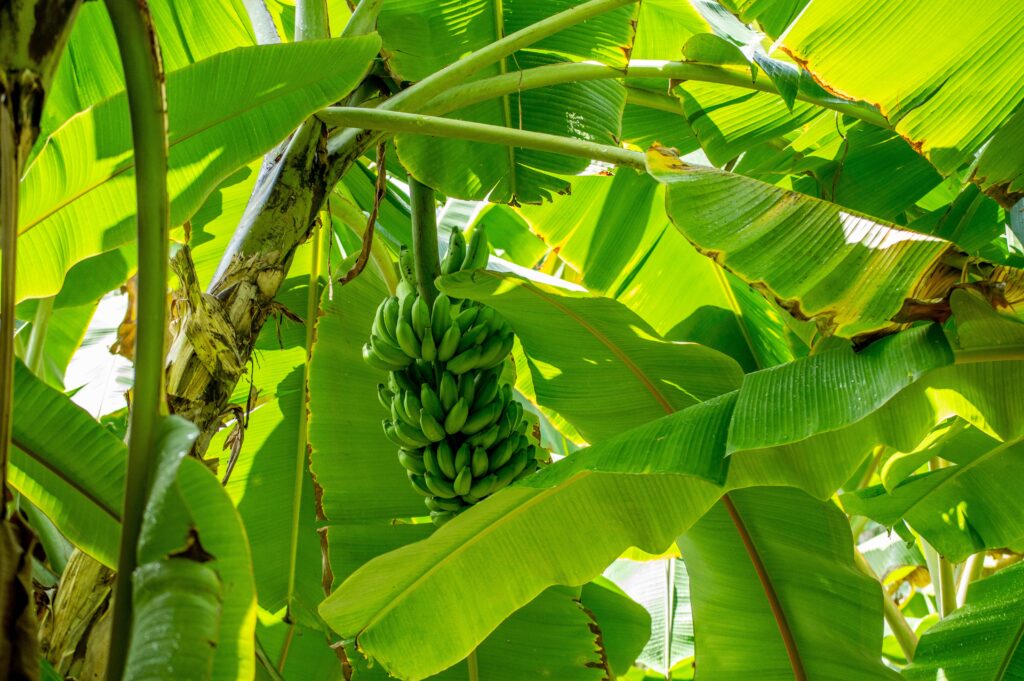
How to Grow the Best Tasting Bananas
To ensure your banana plants thrive, it’s essential to understand the environmental factors that influence their growth:
Temperatures
Bananas thrive in consistently warm to hot conditions. The optimal temperatures are between 78°F to 82°F, although they fruit best at 84°F to 86°F.
When temperatures drop below 60°F, the growth of banana plants slows down, and it completely stops at 50°F. So, you won’t see much progress on your bananas during the winter.
Unfortunately, cooler winter days can really stunt the growth of your banana fruits when temperatures are between 32°F and 50°F.
The plants themselves can become damaged when temperatures drop below freezing for many hours. Signs of freeze damage include the death of leaves and browning of the trunk and fruit.
Temps below 28°F (-2°C) may even kill the plants, but they usually regrow from the underground rhizome once warm weather returns.
On the other hand, excessively high temperatures at or above 98°F (37°C) can lead to leaf scorch, and newly emerging leaves may appear very narrow. This is why you may want to consider planting your bananas in some dappled shade if you’re in South Florida.
Sun and Wind Exposure
Wind can damage banana leaves, so consider planting in a sheltered location or using windbreaks. This may also provide some protection from summer scorching.
Bananas thrive in full sun but can tolerate partial shade, especially during the hottest part of the day.
Drought and Flooding: While bananas prefer consistent moisture, they can tolerate short periods of drought. Avoid waterlogged conditions.
Grow Bananas in Florida Soil
Bananas thrive in well-drained soil rich in organic matter. Sandy loam soils are ideal, but heavy clay soils can be amended with organic matter to improve drainage. Add compost or well-rotted manure to enhance soil fertility.
Bananas are sensitive to high salt levels in the soil. Choose well-draining soils with low salinity.
When to Grow Bananas in Florida
The ideal time to plant bananas in Florida varies by zone:
- Zone 8: Plant bananas in early spring after the threat of frost has passed.
- Zone 9: Plant in late winter or early spring.
- Zone 10: Plant year-round, avoiding the hottest months of summer.
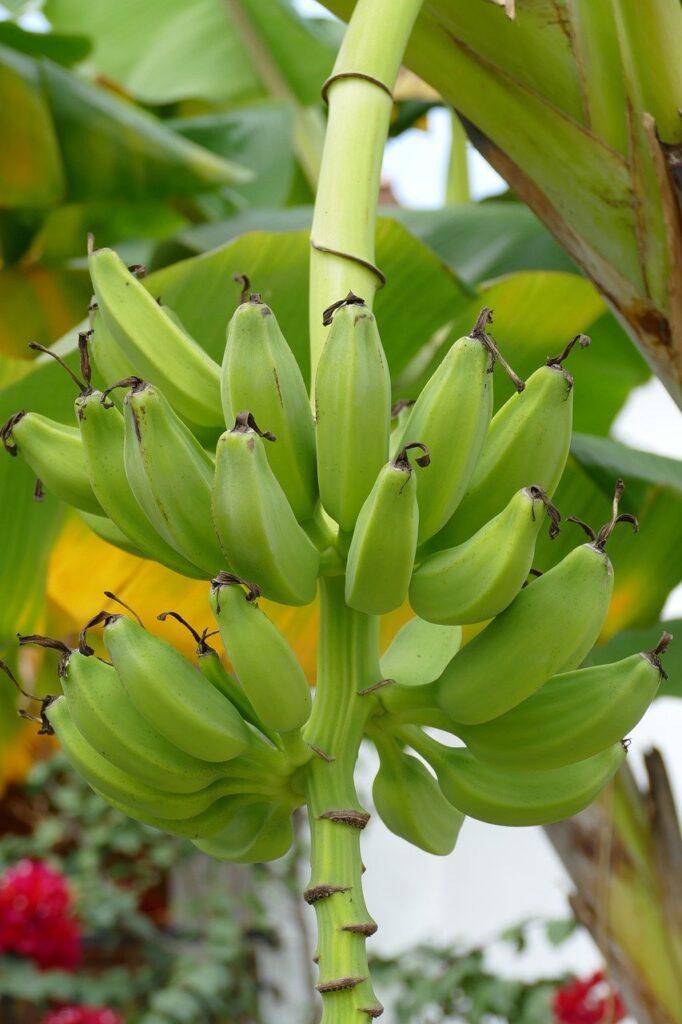
Circle the Bananas
Banana circles, also known as banana pits or banana circles, have gained popularity among permaculture enthusiasts as an innovative and sustainable way to grow bananas.
This method draws inspiration from traditional agricultural practices found in various cultures around the world. While the exact origins of banana circles are difficult to trace, their use can be seen in regions such as Southeast Asia, Africa, and South America, where bananas have been cultivated for centuries.
The concept behind banana circles revolves around creating a self-sustaining ecosystem that mimics the natural conditions in which bananas thrive. It involves digging a circular pit in the ground and gradually building up layers of organic matter within it. The organic materials used can include kitchen scraps, compost, mulch, leaves, straw, animal manure, and any other biodegradable waste readily available. As these materials decompose, they release nutrients into the soil, creating a fertile environment for banana plants.
Banana circles offer several advantages for banana cultivation. Firstly, the circular shape provides an efficient use of space, allowing multiple banana plants to be grown in a compact area. This is especially beneficial for home gardeners with limited space.
Additionally, the layers of organic matter create a moisture-retaining and nutrient-rich environment, reducing the need for frequent watering and fertilization. The organic matter also acts as a mulch, helping to suppress weeds and maintain soil moisture levels.
Banana circles are a holistic way to grow bananas in Florida and they utilize natural processes and recycle organic waste. They promote soil health, conserve water, and encourage biodiversity by creating microhabitats that attract beneficial insects and microorganisms.
Banana circles contribute to the overall resilience of the garden ecosystem, as the decomposing organic matter feeds not only the banana plants but also neighboring plants and soil organisms.
These circles not only provide an abundant harvest of bananas but also provide a lightly shaded understory for growing more sun-sensitive plants in rich and fertile soil.
Planting a Banana Circle
Creating a banana circle, as practiced in permaculture, can optimize growth and provide a sustainable environment for your banana plants. Follow these simple steps to create a banana circle:
- Choose a sunny or partially shaded location that is somewhat sheltered from harsh or excess wings.
- Dig a circular trench approximately 1-3 feet deep and 3 feet wide.
- Place organic matter, such as leaves or compost, kitchen scraps, composted manure, etc. in the bottom of the trench.
- Plant your banana pups around the inner edge of the circle, leaving space for growth.
- Backfill the trench with soil and water thoroughly.
- Mulch the area around the circle to conserve moisture and suppress weeds.
Care Tips for the Best Tasting Banana
To ensure healthy and fruitful banana plants, follow these care tips:
Feeding Your Bananas
Fertilizing bananas is essential for promoting healthy growth and maximizing fruit production. The timing and nutrient requirements may vary based on the growth stage and the specific USDA growing zone in Florida. In general, it is recommended to fertilize bananas during the active growing season, which typically spans from spring to early fall.
USDA Zone 8
For USDA Zone 8, it is advisable to apply fertilizer in early spring, around March or April, to provide the necessary nutrients for robust growth. Repeat the application every six to eight weeks until early fall.
USDA Zone 9
In USDA Zone 9, where the growing season is longer, you can begin fertilizing in late winter or early spring, around February or March. Continue fertilization every six to eight weeks throughout the growing season.
USDA Zone 10
In USDA Zone 10, with its year-round warm climate, bananas benefit from regular fertilization. Begin fertilizing in early spring and continue every six to eight weeks, maintaining a consistent nutrient supply.
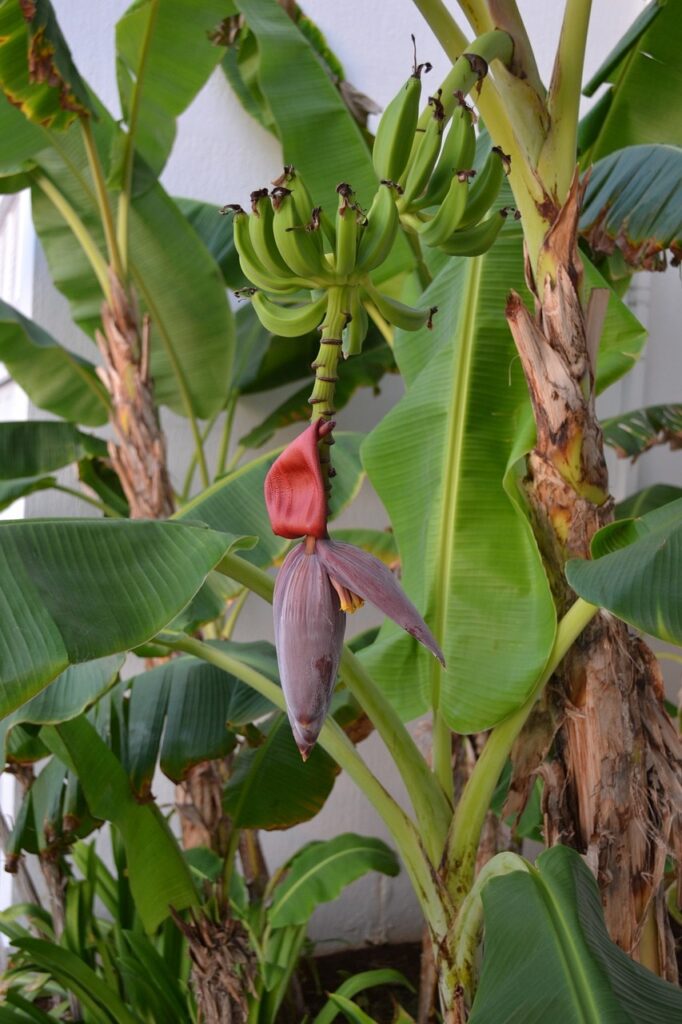
The Macros and Micros
When it comes to nutrient requirements, bananas have specific needs to thrive. The primary macronutrients required are nitrogen (N), phosphorus (P), and potassium (K). The recommended NPK formula for edible bananas is generally around 3-1-6 or 2-1-6. This means that the fertilizer should have a higher potassium content compared to nitrogen and phosphorus. This balanced ratio helps promote healthy foliage growth, sturdy stems, and enhanced fruit development.
In addition to the macronutrients, bananas also require various micronutrients for optimal growth. Some essential micronutrients for bananas include magnesium (Mg), iron (Fe), manganese (Mn), zinc (Zn), copper (Cu), and boron (B). These micronutrients play crucial roles in enzyme activation, chlorophyll production, and overall plant health. It is recommended to use a fertilizer that includes these micronutrients in its formulation or supplement with micronutrient-specific products as needed.
Organic Fertilizer for Bananas
For those preferring organic alternatives to commercial fertilizers, several options are available. Organic materials such as compost, well-rotted manure, and worm castings can provide a rich source of nutrients for bananas. Additionally, organic fertilizers made from natural sources like fish emulsion, seaweed extracts, and bone meal can be effective in meeting the nutritional needs of banana plants. These organic alternatives offer sustainable options while nourishing the soil and supporting healthy growth.
Irrigation for Bananas
Bananas require consistent moisture. Provide regular deep watering to keep the soil evenly moist.
Mulching helps suppress weeds and conserve moisture. Use chop and drop when trimming browned leaves. They will break down in the soil and provide nutrients while helping to retain moisture in the soil until they do.
It’s especially important to provide water throughout the winter and spring in Central and South Florida. Once you pass your last freeze date, you’ll need to water your bananas regularly until the rainy season begins.
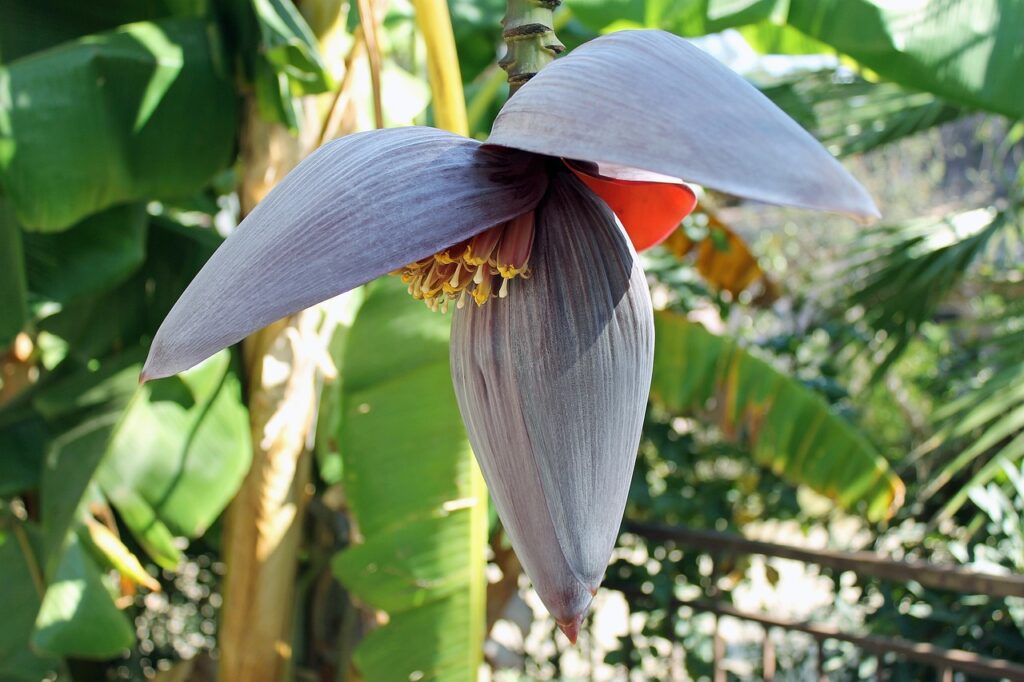
How to Harvest Your Banana Crop
Bananas typically take around 9-15 months to mature, depending on the variety. Once the flower has produced as much fruit as it will, the bananas will begin to grow larger and become plump.
At this point, you can cut off the remaining flower if you like. I haven’t noticed any difference between leaving them on or cutting them off. Many people enjoy eating banana flowers in regional dishes, but I normally cut them down to prevent stressing the pseudostem. I drop them into the middle of the circle to compost.
Once they reach their mature size, the top bananas on the stalk will begin to turn yellow. That’s when it’s time to harvest.
You can harvest each hand of bananas individually as they become ripe, if you choose. Cut them from the stalk with a sharp knife.
Alternatively, you can harvest the whole stalk by cutting it about 10-12″ above the top hand of bananas. You can hang them up in a utility room or garage to finish ripening.
Note that the bananas will begin to fall off the stem as they ripen, so you’ll want to make sure you harvest them regularly so you don’t end up with a pile of rotten bananas under the stalk.
The Tragedy of Bananas
Once a banana plants fruits, it will die off. So, you won’t get any more bananas from the same plant once it has. However, you will get new banana plants growing from the rhizomes below.
Many times, you’ll see several pop up before the plant even blooms, which is reassuring when you realize that the plant will die after fruiting.
I’ve noticed that Dwarf Cavendish will definitely throw out two or three pups before blooming. I have a few other varieties that I’ve forgotten the names of that don’t send up pups as prolifically.
Sometimes you’ll get more pups from the rhizome, even though the mother plant appears to be completely dead. If you’re using the banana circle method, allow the “tree” to brown and dry out completely. Once it is completely dead, you can just push it over and allow it to gently decompose within the circle.
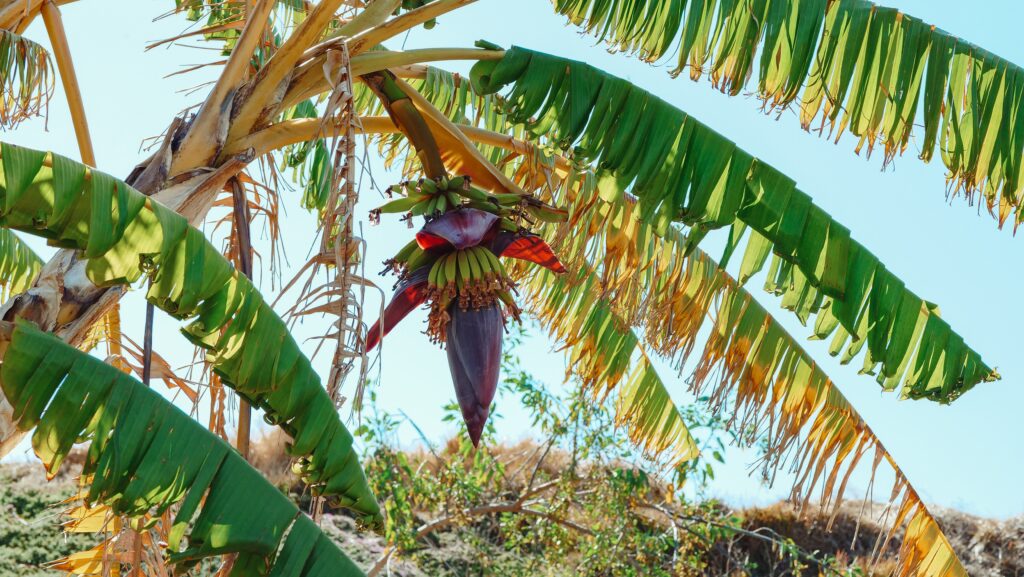
Time to Grow Bananas in Florida
By now, you’re equipped with the knowledge you need to grow bananas in your Florida garden. Take advantage of the summer rainy season to get your own mini-plantation going this summer.
Roll up your sleeves, get your hands dirty, and embrace the joy of growing bananas in Florida. Start your journey towards self-sustainability and enjoy the delectable flavors of homegrown tropical fruits right in your own backyard. Happy gardening!